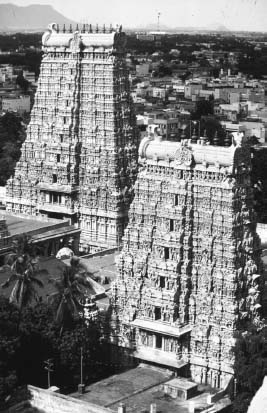HinduismSigns and Symbols |
Do Hindus mark their sacred spaces with any distinctive signs and symbols? |
Hindu temples are often very easily identified, especially if the sacred place has been built as such from the start, rather than occupying a structure originally designed for some other purpose. Two major architectural styles developed in India. The “Southern” style features three-tiered pyramidal spires (called shikhara) atop each of the temple’s interior shrines or “womb chambers” (garbha griha). A monumental trapezoidal facade called a “royal gateway” (raja gopuram) typically rises thirty to fifty feet above the main roofline. Both the spires and the facade are nowadays generally finished in white, with small gold finials on top. Southern temples often house several shrines under a single flat roof, with the individual spires of the shrines protruding through the roof and visible to all who approach. The classic “Northern” style historically had a large outer unroofed enclosure, within which stood a series of separate ritual spaces arranged additively along a single east-west axis.
As in the southern style, the center of northern temples is always the shrine or womb chamber, typically a small dark room with only one door and a tall multitiered spire above. Attached to the shrine by a narrow passageway toward the east one might find a larger room for devotees to gather, and sometimes another, still larger, east of that dedicated to other ritual needs, such as ritual dancing. In other words, the various ritual functions the southern style puts together under one roof, the northern style arranges in more or less distinct spaces that look like small separate structures. Most of the Hindu temples built recently in the United States are in the southern style. The overall design is more convenient in multiseasonal so that one temple can serve the needs of members of various denominations.

Two sculpture-covered “royal gateways” at the Temple of Minakshi, Madurai. (Photo courtesy of Michael Harter, S.J.)
